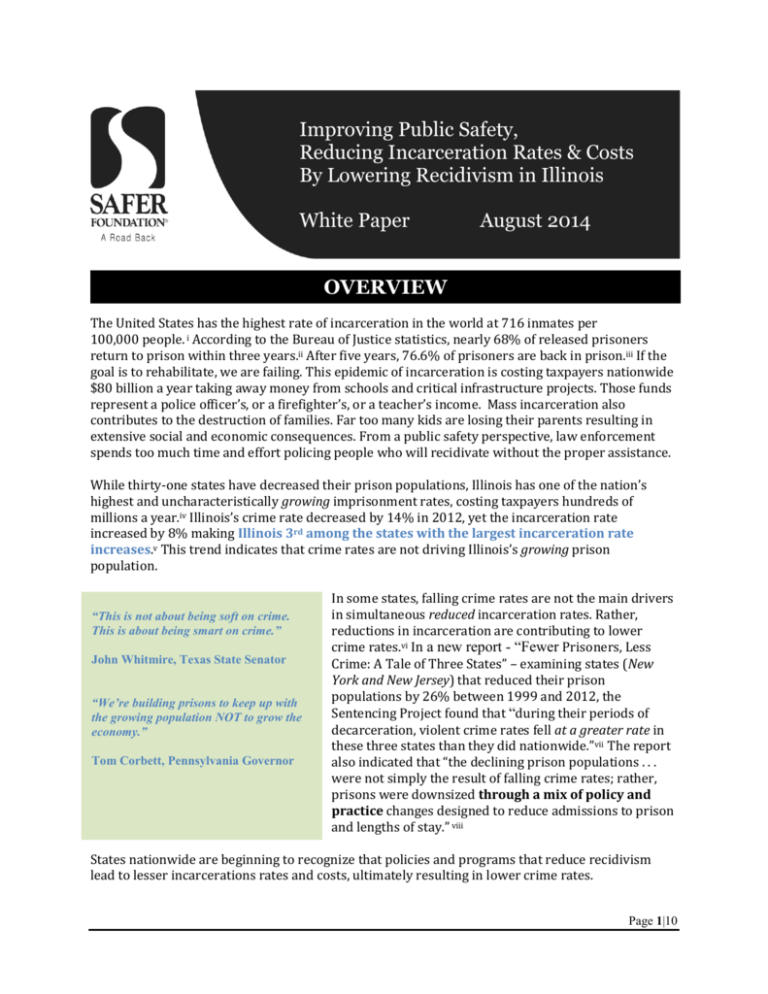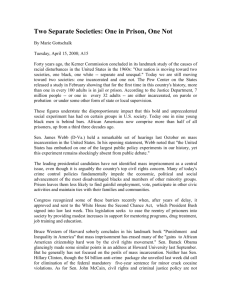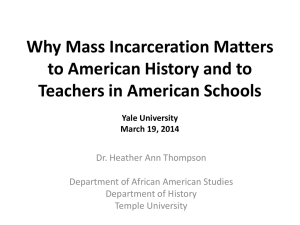Improving Public Safety, Reducing Incarceration
advertisement

Improving Public Safety, Reducing Incarceration Rates & Costs By Lowering Recidivism in Illinois White Paper August 2014 OVERVIEW The United States has the highest rate of incarceration in the world at 716 inmates per 100,000 people. i According to the Bureau of Justice statistics, nearly 68% of released prisoners return to prison within three years.ii After five years, 76.6% of prisoners are back in prison.iii If the goal is to rehabilitate, we are failing. This epidemic of incarceration is costing taxpayers nationwide $80 billion a year taking away money from schools and critical infrastructure projects. Those funds represent a police officer’s, or a firefighter’s, or a teacher’s income. Mass incarceration also contributes to the destruction of families. Far too many kids are losing their parents resulting in extensive social and economic consequences. From a public safety perspective, law enforcement spends too much time and effort policing people who will recidivate without the proper assistance. While thirty-one states have decreased their prison populations, Illinois has one of the nation’s highest and uncharacteristically growing imprisonment rates, costing taxpayers hundreds of millions a year.iv Illinois’s crime rate decreased by 14% in 2012, yet the incarceration rate increased by 8% making Illinois 3rd among the states with the largest incarceration rate increases.v This trend indicates that crime rates are not driving Illinois’s growing prison population. “This is not about being soft on crime. This is about being smart on crime.” John Whitmire, Texas State Senator “We’re building prisons to keep up with the growing population NOT to grow the economy.” Tom Corbett, Pennsylvania Governor In some states, falling crime rates are not the main drivers in simultaneous reduced incarceration rates. Rather, reductions in incarceration are contributing to lower crime rates.vi In a new report - “Fewer Prisoners, Less Crime: A Tale of Three States” – examining states (New York and New Jersey) that reduced their prison populations by 26% between 1999 and 2012, the Sentencing Project found that “during their periods of decarceration, violent crime rates fell at a greater rate in these three states than they did nationwide.”vii The report also indicated that “the declining prison populations . . . were not simply the result of falling crime rates; rather, prisons were downsized through a mix of policy and practice changes designed to reduce admissions to prison and lengths of stay.” viii States nationwide are beginning to recognize that policies and programs that reduce recidivism lead to lesser incarcerations rates and costs, ultimately resulting in lower crime rates. Page 1|10 These programs are good for public safety, make fiscal sense, and strengthen communities of returning citizens thereby helping the economy. Improving employment outcomes for persons with criminal records is one of the most successful methods of improving the reentry of returning citizens to their communities and reducing recidivism. A July 2014 Illinois Results First Cost Benefit Analysis, produced by the Illinois Sentencing Policy Advisory Council (SPAC) , identified Employment Training & Job Assistance in the Community as having the best benefit to cost ratio of any effort to reduce reconvictions.ix In some areas, like our juvenile justice system, Illinois has emerged as a national leader in criminal justice reform initiatives. Officials and leaders in Illinois can continue to reverse the mass incarceration cycle and get a better return on their public safety investment by refocusing adult corrections spending – taking the emphasis off of incarceration – and directing it to communitybased employment programs and community corrections. Access to jobs for people with criminal records isn’t just about giving a second chance to those individuals; it’s also an important investment in Illinois’s future that will save the state hundreds of millions of dollars. PRISON GROWTH WILL COST ILLINOIS TAXPAYERS MILLIONS Corrections spending from Illinois’s general fund between 1995 and 2005 rose by 70 percent, from $705 million to $1.2 billion.x During that period, the state’s prison population increased by 18 percent to 44,919.xi In FY10, the Illinois Department of Corrections had an estimated $1.2 billion in prison costs.xii The state had an extra $566.1 million in prison-related costs outside the budget.xiii Including the additional costs, the total state cost was $1.7 billion, for an average annual cost of $38,268 per inmate, and a total per taxpayer cost of $1,743.20.xiv These calculations were based upon the 2010 average daily population of 45,551.xv In April 2014, the total population of inmates reached a high of 49,091.xvi Illinois is projected to increase the number of inmates to 50,065 by March 2015.xvii Given the estimated cost of each prisoner in FY10, we can anticipate that incarcerating more people each year will cost Illinois taxpayers hundreds of millions more. BUILDING STRONG AND SAFE COMMUNITIES: WHY WE NEED ALTERNATIVES TO INCARCERATION High recidivism rates mean more crime, more victims, more pressure on communities and families, as well as higher incarceration rates and costs for the State of Illinois and Illinois taxpayers. Budget constraints limit the ability of persons inside of correctional facilities to access desperately needed reentry services. This continues the generational cycles of incarceration that exist in communities across the state of Illinois. Upon release, many individuals are not Page 2|10 www.saferfoundation.org prepared to deal with the environmental, social, and familial demands placed upon them, and as a result, will cycle back into the penal system. Martin Guervara Urbina (2012) argues that “the most crucial gap to the establishment of social control remains to be bridged: from prison to community. Otherwise, with limited resources, a chaotic environment, and a hostile community, released inmates are likely to return to prison.” (p.292)xviii “Chicago Communities and Prison Reentry” (2005) described the community context to which male prisoners returned to Chicago’s 77 communities. They found that over half of released prisoners returned to seven communities with similar economic and demographic characteristics such as below average high school graduation rates, above average poverty rates and crime rates, etc.xix However, a closer look suggests former prisoners face a variety of other obstacles, including social isolation and disenfranchisement, housing challenges, deindustrialization, and lack of social service infrastructure.xx Many also struggle with substance abuse, homelessness, and family issues. According to the Urban Institute, most individuals released from prison held some type of job prior to incarceration and want legal, stable employment upon release. However, most former prisoners experience difficulty finding a job after release.”xxi The researchers found that two months after being released only 31 percent of inmates were employed.xxii Even eight months after release, fewer than half were currently employed.xxiii In fact, only about half of formerly incarcerated men and women find employment within a year of being released from prison or jail.xxiv Facing these multiple barriers, along with the shortage of resources and lack of family support, leads many people to frustration, increases their chance of committing another crime, and returning to prison.xxv Without positive intervention, almost half (47%) of the inmates released from IDOC prisons will be back to prison within three years after violating their parole or committing new crimes.xxvi As mentioned previously, over half of prisoners are released to seven communities which have much higher recidivism rates than the statewide average. In 2012, 31,460 prisoners were released from Illinois prisonsxxvii meaning that we can estimate that by 2015, at least 14,000 will return back to prison. This is an escalating cycle of repeat offending and incarceration with costs that are no longer sustainable in Illinois. Many communities in Illinois are significantly impacted by the cycle of incarceration and reentry. These communities, overwhelmed from high poverty, crime, and violence rates, and lack of funding, are struggling to provide basic social services. The cost of high recidivism to families is staggering. Many of those in the cycle of incarceration have children who may likely become at high risk for involvement in the juvenile justice system if their parent(s) are in the system. Further, community residents are victimized by formerly incarcerated individuals who are committing more crimes. Employment is the gateway for those in the cycle of incarceration to a road back to becoming and remaining law-abiding and contributing members in our communities. Page 3|10 www.saferfoundation.org RECOMMENDATIONS “Safe, secure, orderly prisons – those are bedrock. But we can truly deliver on our commitment to the safety of our citizens by also assuming leadership in implementing principles and practices that reduce post-release recidivism.” A.T. Wall, Director Rhode Island Department of Corrections RECOMMENDATION 1: Illinois should lay the foundation for reducing incarceration rates and costs by directing resources to community-based programs that reduce recidivism by providing employment training, supportive services, and educational programming to diversion candidates and returning citizens. These communitybased programs should be deployed as a diversion opportunity to prevent reconvictions and as pre/post release reentry programs. Community-based employment and reentry programs give diverted & returning citizens the opportunity to receive education and develop skills leading to jobs, assistance in securing a job, as well as support to overcome drug addiction, and mental help problems that threaten jobs and increase recidivism. These programs help improve public safety by ensuring that diverted & returning citizens are less inclined to commit crime and remain in their communities with support systems and families, while receiving services and gaining employment. Their time is being spent productively in a structured work environment making it less likely that they will engage in riskier behaviors, or engage with people who do. If they are working, the costs to Illinois’s taxpayers for re-incarceration decreases, while the contributions to the tax base for vital community services increase. They are also more likely to be able to provide for their families and develop pro-social relationships strengthening their support systems, resulting in stronger positive relationships and better mental health. Safer Model Recognizing the crucial role that employment plays in the adjustment of formerly incarcerated persons, the Safer Foundation (Safer) assists clients to seek and maintain gainful employment. Safer Foundation – headquartered in Chicago, Illinois – is one of the nation’s largest not-for-profit providers of services designed exclusively for people with criminal records. Last year, Safer helped more than 4,200 men and women with criminal records secure employment. Safer’s Workforce Strategies Division supports employers throughout the Chicago metropolitan area to fill position openings with Safer’s participants. Safer has a database of over 450 employers who hire adults with criminal records. Page 4|10 www.saferfoundation.org Employment and employment-related services are the cornerstones of Safer’s service delivery system, including job preparedness, placement (transitional and long-term employment), and retention services. In 2006, Safer implemented a redesigned Employment Retention Services model. The redesign was intended to improve the job readiness level of participants and broaden the number as well as quality of job opportunities, thus increasing job placement and retention as well as reducing recidivism and increasing public safety. Recidivism Reductions and Outcomes of Success Research points to the value of employment, and employment-related services, to improve outcomes. Safer’s last recidivism study conducted by Loyola University revealed that the recidivism rate for Safer Foundation clients who received Safer’s employment services and achieved employment was 24.3%. The three-year recidivism rate for Safer Foundation clients who achieved 30-day employment retention was 17.5%, a 63% lower recidivism rate than the statewide recidivism rate of those released from prison during the same time period.xxviii Among those who went on to achieve 360-day retention, only 15.7% recidivated in a threeyear period after achieving the 360-day retention. Taxpayer Savings Public Safety Recidivism Incarceration Rates & Costs Crime By keeping people from returning to prison, Safer Foundation provides considerable relief to the state’s economy, saving taxpayers millions of dollars. When our clients find employment, they no longer become a drain on the economy, and instead, become valuable contributors. With more than 10,000 job starts in the last 4 years, Safer Foundation saved the state more than $300 million by keeping people out of state prisons, and helping them to become productive, law-abiding citizens, positively contributing to their families, and their communities. Page 5|10 www.saferfoundation.org RECOMMENDATION 2: Illinois should reduce reliance on institutional corrections – incarceration in jails or prisons – and budget more funding to community based Adult Transitional Centers. Community Correction Centers are vital in providing incarcerated individuals with the opportunity to restructure and stabilize their lives with employment, providing them with a second chance at life. Currently, Adult Transitional Centers (ATCs) in Illinois represent less than 2% of IDOC bedspace with 958 beds (580 beds for men operated by Safer).xxix The Crossroads Adult Transition Center Outcomes of Success Safer is the only non-profit agency to operate two secured residential Adult Transitional Centers (ATCs) on behalf of the Illinois Department of Corrections. Prior to their release from custody, the Crossroads and North Lawndale Adult Transition Centers offer men who have non-violent offenses, with less than two years remaining on their sentences, the opportunity to gradually transition to the community. Safer’s minimum security residential facilities have 580 beds, and are typically almost at their maximum operational capacity. About 750 men are served each year in this program with the average stay being about 12months. For more details on programming, see Safer Highlights. Since 2000, served 7,377 inmates with 1,475 receiving substance abuse treatment, 832 obtaining GEDs, and 5,532 (about 75%) obtaining job starts. Recidivism rate is 31.4% for the last three years, compared to IDOC rate of app. 47% Houses up to 380 men are housed in the facility at a little more than half the cost of the state per day rate of app. $38,000. In FY14, 82% of those who have been there 30 days or more are eligible to seek employment, and are employed, with a job retention rate of 63%. In 2012, Crossroads residents alone had an annual economic impact of $2.4 million, including paying $165,000 in taxes, in addition to paying child support and preparing to return to their families and communities in other ways. Page 6|10 www.saferfoundation.org CONCLUSION As states and localities are examining cost-saving measures and eliminating inefficient and costly programs, they should consider transferring funds from incarceration to community-based employment programs for diversion candidates and returning citizens. In addition, using community corrections for less serious crimes can be an effective approach in keeping Illinois’s communities safe and saving money. If we do not shift our resources to alternatives to incarceration there are real risks: unsuccessful transition from prison & reconviction (the revolving door syndrome); communities and human services providers being forced to bear the burden of managing unemployed persons with records; staggering incarceration costs; and, reduced public safety. However, if Illinois considers, and implements these recommendations, critical diversion & reentry services will be provided, strengthening families and communities, and providing employers with a qualified workforce; all while significantly improving tax-payers’ return on Illinois’s investment of corrections dollars. Page 7|10 www.saferfoundation.org ____________________________________________________ Endnotes International Centre for Prison Studies, “Highest to Lowest – Prison Population Total,” http://www.huffingtonpost.com/2013/08/13/incarceration-rate-per-capita_n_3745291.html. ii Cooper, Alexia et al., “Recidivism of Prisoners Released in 30 states in 2005: Patterns from 2005 to 2010,” Bureau of Justice Statistics (April 2014), NCJ 244205, available at http://www.bjs.gov/index.cfm?ty=pbdetail&iid=4986. iii Ibid. iv The Pew Charitable Trusts, “States Cut Both Crime and Imprisonment,” December 19, 2013, available at http://www.pewstates.org/research/data-visualizations/states-cut-both-crime-and-imprisonment85899528171. v Ibid. vi The Sentencing Project, “Fewer Prisoners, Less Crime: A Tale of Three States,” (July 23, 2014), available at http://sentencingproject.org/doc/publications/inc_Fewer_Prisoners_Less_Crime.pdf. vii Ibid. viii Ibid. ix Kathryn Saltmarsh, “Illinois Results First Cost-Benefit Analysis,” Illinois Sentencing Policy Advisory Council (July 15, 2014). x Vera Institute of Justice, “The Price of Prisons: Illinois – What Incarceration Costs Taxpayers,” (Jan. 2012), available at http://www.vera.org/sites/default/files/resources/downloads/the-price-of-prisons-40-factsheets-updated-072012.pdf. xi Ibid. xiiIbid. xiii Ibid. xiv Ibid. xv Ibid. xvi Illinois Department of Corrections, “Quarterly Report,” (April 2014), available at https://www2.illinois.gov/idoc/reportsandstatistics/Documents/IDOC_Quarterly_Report_Apr_%202014.pdf. xvii Ibid. xviii Urbina, M. G. (2012) “Life after Prison: Ethnic, Racial, and Gender Realities” in Martin G. Urbina (Ed) Hispanics in the U.S. Criminal Justice System: The New American Demography, pp. 291 – 314; Springfield: C.C.Thomas. xix Visher, C. & Farrell, J., “Chicago Communities and Prison Reentry, (2005) Washington, DC: Urban Institute. xxIbid. xxi Visher, Christy, et al., “Employment after Prison: A Longitudinal Study of Releases in Three States,” at Pg. 1. Urban Institute Justice Policy Center. October 2008, available at http://www.urban.org/UploadedPDF/411778_employment_after_prison.pdf. xxii Ibid. xxiii Ibid. xxiv Ibid. xxv Urbina, M. G. (2012) “Life after Prison: Ethnic, Racial, and Gender Realities” in Martin G. Urbina (Ed) Hispanics in the U.S. Criminal Justice System: The New American Demography, pp. 291 – 314; Springfield: C.C.Thomas. xxvi Recidivism percent (47.0%) based on the IDOC FY2011 recidivism percent for inmates released in FY2008 from IDOC and re-incarcerated within three years of release. xxvii Illinois Department of Corrections, “Fiscal Year 2012 Annual Report,” available at http://www2.illinois.gov/idoc/reportsandstatistics/documents/fy2012%20annual%20report.pdf. i Page 8|10 www.saferfoundation.org xxviiiRecidivism percent (47.0%) based on the IDOC FY2011 recidivism percent for inmates released in FY2008 from IDOC and re-incarcerated within three years of release. xxix John Howard Association of Illinois, “2014 Monitoring Visit to Crossroads Adult Transitional Center,” available at http://thejha.org/sites/default/files/Crossroads%20Adult%20Transitional%20Center%20Report%202014 %20%284%29.pdf. Page 9|10 www.saferfoundation.org Safer Foundation 571 W. Jackson Blvd. Chicago, IL 60661-5701 (312) 922-2200 Fax: (312) 922-0839 www.saferfoundation.org Page 10|10 www.saferfoundation.org






